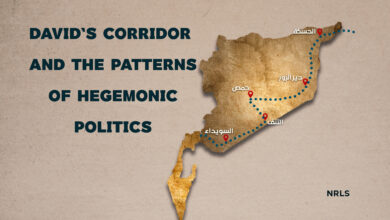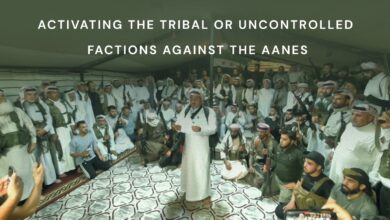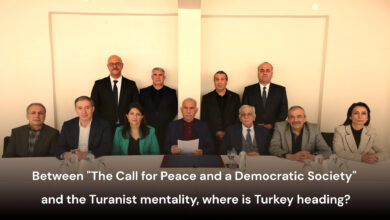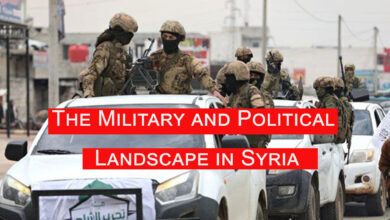HTS and expansionist policy in the occupied areas
HTS and expansionist policy in the occupied areas

What is happening in northern Syria of the expansion of the influence of Hayat Tahrir al-Sham (HTS – al-Nusra Front), which is classified as a terrorist organization, at the expense of the influence of the mercenaries of the Syrian National Army (SNA) of the Turkish occupation has begun to draw the attention of the world especially Syrian people. It seems that what is emerging on the ground is not a coincidence but rather a reflection of the new Turkish policy towards Syrian crisis especially after the recent meetings between Turkish President Recep Tayyip Erdogan and Russian President Vladimir Putin and on the other hand with Iran. It seems that Turkey is trying in every way to maintain a balance between its domestic and foreign policy, as there is an interior crisis that threatens Erdogan’s stay in power due to the deterioration of the Turkish economy and the Turks’ resentment over the presence of Syrian refugees in addition to the Turkish army’s failure to achieve strategic successes in Kurdistan and Rojava (northern Syria). At the same time, there is Russian-Iranian pressure on the areas occupied by Turkey in the west of the Euphrates River. These matters may push Erdogan to accept international deals in order to preserve power in the upcoming elections; The Turkish proposal of reconciliation between Syrian opposition and Syrian regime falls within this context. This proposal has created conflicting reactions among the opposition, as there appeared those who reject the final reconciliation with the regime despite the Turkish instruction to them. On the other hand, the Syrian regime and its supporter insist on the need that the Turkish occupation must take realistic steps to rebuild trust with it with a Russian guarantee. In conjunction with this, the HTS began to expand in the northern countryside of Idlib and Aleppo which are under the control of the mercenaries of the SNA – the Third Legion. According to some local sources, the HTS is trying to win over citizens, especially the indigenous population of the Kurds and pretending to be a savior from the violations of its peers from the factions. It also opened offices for them under the names of Grievance Response Office, Complaints Office, and Security Preservation Office. At the same time, the HTS imposed wearing veil in some public institutions such as Afrin Hospital and imposed a tax on citizens under the name zakat. It seems that it is trying to reproduce its experience in Idlib in the areas in which it is expanding, and at the same time it is trying to win the sympathy of the region’s residents, both the indigenous people and the settlers. These developments raised many questions about their timing and purpose, especially as they will cause northern Syria to enter a new phase in all political, military and economic aspects.
When examining the security and military scenes in those areas, several speculations come to mind, perhaps the most prominent of which are attempting to recycle the opposition to conform to the conditions of the current Syrian crisis in all its internal, regional and international dimensions. There is a high possibility that the Syrian regime will enter large areas of Idlib with the aim of controlling Bab al-Hawa border crossing, at least, in the current stage in preparation for more expansion in the future and the start of large-scale settlement processes in that area in a manner that serves rapprochement between the Syrian regime and the Turkish regime within the framework of the understandings that are concluded between the guarantors of Astana and creating a situation to attract the Syrian people to settlement and also to encourage the Syrians inside Turkey to return with the aim of easing the tension inside Turkey, and at the same time investing Putin’s current strategy that focuses on linking his public policies in favor of his war in Ukraine, as he offered a tempting agreement to make Turkey a center for the distribution of Russian gas towards Europe, and it seems that the commercial deals between the two parties control the strategic paths. However, this policy may not be compatible with the strategy of the HTS which seeks to establish an Islamic emirate in the region, especially as it works to create an illusion among the Syrian people displaced to northwest Syria that all Syrian lands are destined to return to the control of the Syrian government, which imposes on the displaced and the armed factions to conduct extensive settlement operations with the aim of saving their lives because the classification of the HTS on the blacklist may expose the area to bombardment by all parties including the Russians and the regime, which makes the area more vulnerable to emergency military developments.
As for the second possibility, it may lie in the presence of other Turkish goals to bless the expansion of the HTS with the aim of unifying northwest Syria under one banner after the failure of most of the mercenary factions (SNA) to achieve any stability in the occupied areas, in order to use them to strike the project of the Autonomous Administration of North and East Syria (AANES), and this is the goal of both Syrian regime and Russia in order to impose new agendas on the Syrian reality in line with their policy in the region. Therefore, Turkey may give up some areas in favor of the Syrian regime and Russia in exchange for the restoration of relations between the two parties and the strengthening of their joint cooperation against the AANES. However, what hinders this is the ideological hostility of the HTS towards the Russian, Syrian, Iranian and, to some extent, the Turkish Muslim Brotherhood regimes, so it seems that this possibility is a tactical option rather than a strategic one.
It also seems that these two possibilities are somewhat incompatible with the Western position on the Syrian crisis, where one of the American officials expressed his concern about what is happening in that region and demanded that the Turkish occupation stop the expansion of the HTS in the occupied areas which are controlled by the mercenaries of the SNA. At the same time, the control of the HTS over this area may constitute a pretext for the Syrian regime forces and their allies of the Russians and Iranians to attack the area in light of the large military build-up on the frontlines between the two parties.
Undoubtedly, the changes that are taking place in northern Syria will have a direct impact on the future of northeastern Syria, i.e. the areas of the AANES in particular and Syria in general, as it constitutes a strategic target for Turkey, Russia, Iran, the regime and the West, and it is not excluded that the Turkish occupation and its Astana guarantors to create the conditions for the HTS to attack the Syrian Democratic Forces (SDF) and pressure the US-led Global Coalition to Defeat ISIS to make concessions to Turkey in the city of Manbij and other areas. It also seems that the Turkish occupation will try by various means to destabilize the region and achieve its hegemonic agendas and seek to strike the ANESS and its military forces – SDF – whenever it has the opportunity. Based on this, the HTS will not mind being in control of the entire north of Syria, and Afrin may be the beginning.




